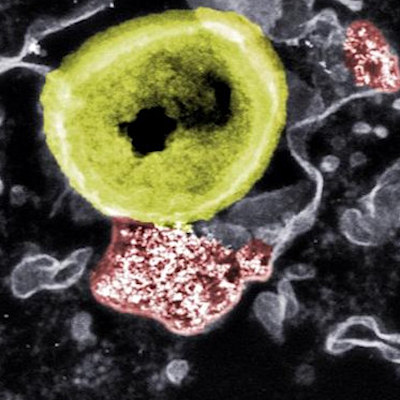December 7, 2021 -- Researchers have engineered a bioinspired molecule that was highly effective in clearing infections caused by antibiotic-resistant bacteria strains in a mouse model, according to a paper published in Scientific Reports on December 6. But there's a twist: The molecule doesn't act like an antibiotic.
Unlike a traditional antibiotic, which works directly on bacteria by killing it or disrupting its growth, the newly engineered molecule, a cycle peptide called minimized theta-defensin (MTD)12813, works indirectly as an immune stimulant.
"We call this peptide a host-directed anti-infective because rather than kill the bacteria directly like traditional antibiotics, it stimulates the host -- us -- to fight the infection," said lead author Justin Schaal, PhD, an assistant professor of research pathology at the Keck School of Medicine of University of the Southern California (USC), Los Angeles, in a statement.
Inspired by natural defenses of old-world monkeys
The development of MTD12813 was inspired by theta-defensins, a family of mammalian antimicrobial peptides that are naturally found in old-world monkeys such as baboons and rhesus monkeys. Using the monkeys' natural theta-defensin RTD-1 as inspiration, Schaal and his colleagues bioengineered similar molecules and screened them for their ability to fight bacterial infections in a mouse model. The cyclic peptide MTD12813 emerged from this process as the most potent candidate, demonstrating 10 times the efficiency of RTD-1 at clearing infections, as well as being highly stable and nontoxic to mice at dose levels 100 times the therapeutic dose level.
While its exact mechanism remains unclear, MTD12813 seems to work by activating cells called macrophages and neutrophils, blood cells recruited by the immune system to engulf and destroy pathogens. The peptide also modulates the cytokine response to bacterial infection in a way that prevents dysregulated cytokine signaling, which can result in uncontrolled inflammation and, in severe cases, organ failure.
Multidrug-resistant bacteria an urgent public health threat
Antibiotic-resistant infections are on the rise, according to the U.S. Centers for Disease Control and Prevention. Known colloquially as superbugs, these bacteria have multidrug resistance (MDR) to all but the most potent antibiotics.
Recently, the public health threat has increased with the emergence of infections by carbapenem-resistant Enterobacteriaceae (CRE) pathogens, which include certain bacterial strains of Escherichia coli and Klebsiella pneumonia. CREs have evolved a resistance to carbapenems, a class of antibiotics that are among the drugs of last resort for infections caused by MDR bacteria.
The USC researchers' testing of MTD12813 in mouse models showed that it was effective against a panel of CRE bacteria that included K. pneumoniae and E. coli strains expressing carbapenemases (specifically KPC-2 and NDM-1). Carbapenemases, enzymes that hydrolyze carbapenem antibiotics, are the most common resistance mechanism among CREs, but they had no effect against the novel peptide.
Partnership with Oryn Therapeutics
MTD12813 will be developed further through a licensing agreement between USC and Oryn Therapeutics, a company founded by co-author Michael Selsted, PhD, also of USC's Keck School of Medicine.
Oryn hopes to develop the technology into treatments for increasingly dangerous bacterial infections. With the race against CREs heating up and increasing concerns that the next pandemic may be bacterial in nature, the timing could not be better, according to Selsted.
"This new discovery of how to stimulate host clearance of bacteria is really timely," he said.
Do you have a unique perspective on your research related to drug discovery? Contact the editor today to learn more.
Copyright © 2021 scienceboard.net







